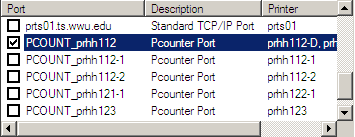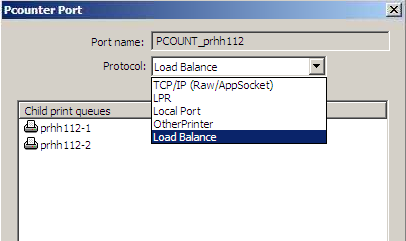Part of the migration project involves moving the print environment over to Windows. One thing is clear, pcounter makes Windows printing actually work. We haven't had a chance to do anything like scale testing to see how stable it is, that'll sadly have to wait until we get enough traffic (i.e. in production).
One of the ways that pcounter helps Windows printing actually work is to rationalize the print-pooling setup. Under standard Windows printing, print pooling is not a load balancing configuration. Additional printers are used when the first printers are busy with jobs, which means that one printer will get the majority of the print jobs. PCounter does true round-robbin to spread the wear-n-tear.
Pcounter does this by creating a new printer-port type called pcounter. This allows it to get creative with how it handles talking to printers.

Hitting Configure brings up the pcounter port config dialog, which you can also get at through the pcounter tools themselves.

There are many types here. Three ways to talk to printers directly, direct IP, LPR, and direct-attach, and two virtual methods. "Load Balance" does what you expect, you pick a number of already configured pcounter ports to put into the list and any jobs submitted to this new port will print in a round-robin fashion to printers in this list. The "OtherPrinter" option allows you to print directly via non-Pcounter printers, but only one. This last option could be useful if you had some kind of print-to-PDF software on the server that you wanted to regulate through pcounter.
The other nifty thing we're getting into is setting up a web-based release station. We could have done this in the past with NetWare, but never got around to it. It has a lot of features we won't use (such as client-codes), but it does what we want and adds a nice feature: quota listing.

That sort of quota list is a very nice thing. One thing that pcounter does NOT do that it did do with eDirectory, was put the quota as an attribute on the user object. Instead it uses a custom database. Unfortunately, this means that quota is no longer LDAP accessible, which will have some implications for some of our internal tools.
Cool stuff. I'm still working with ATUS to come up with a config everyone likes, so we'll see where we end up come fall start.
One of the ways that pcounter helps Windows printing actually work is to rationalize the print-pooling setup. Under standard Windows printing, print pooling is not a load balancing configuration. Additional printers are used when the first printers are busy with jobs, which means that one printer will get the majority of the print jobs. PCounter does true round-robbin to spread the wear-n-tear.
Pcounter does this by creating a new printer-port type called pcounter. This allows it to get creative with how it handles talking to printers.

Hitting Configure brings up the pcounter port config dialog, which you can also get at through the pcounter tools themselves.

There are many types here. Three ways to talk to printers directly, direct IP, LPR, and direct-attach, and two virtual methods. "Load Balance" does what you expect, you pick a number of already configured pcounter ports to put into the list and any jobs submitted to this new port will print in a round-robin fashion to printers in this list. The "OtherPrinter" option allows you to print directly via non-Pcounter printers, but only one. This last option could be useful if you had some kind of print-to-PDF software on the server that you wanted to regulate through pcounter.
The other nifty thing we're getting into is setting up a web-based release station. We could have done this in the past with NetWare, but never got around to it. It has a lot of features we won't use (such as client-codes), but it does what we want and adds a nice feature: quota listing.

That sort of quota list is a very nice thing. One thing that pcounter does NOT do that it did do with eDirectory, was put the quota as an attribute on the user object. Instead it uses a custom database. Unfortunately, this means that quota is no longer LDAP accessible, which will have some implications for some of our internal tools.
Cool stuff. I'm still working with ATUS to come up with a config everyone likes, so we'll see where we end up come fall start.
*cough*http://www.papercut.com/*cough*. Ive been told by folks in education that papercut ends up being less expensive than pcounter. Give it a whirl.